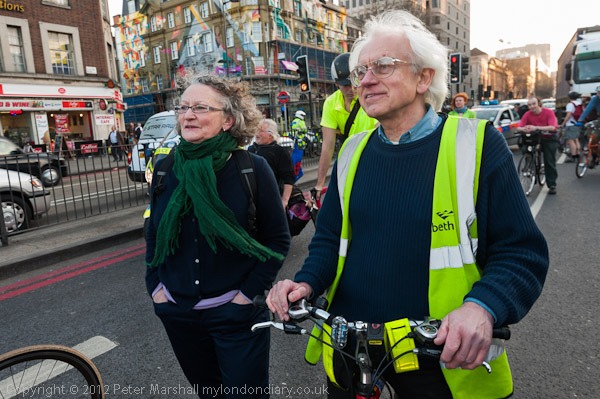London Dyke March 2012
Soho Square - South Bank, London. Sat 31 March 2012
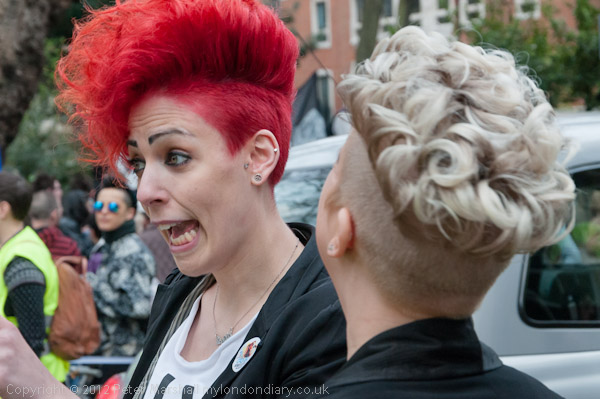
Stella and Lucy of DIVA magazine in Soho Square for
the London Dyke March
more pictures
London's first dyke march since the 1980s began with a rally in Soho Square from which over 600 women then marched through Soho and Trafalgar Square to the National Theatre.
This was an event that brought back memories of the 80s and 90s, before the annual Pride march became a carnival parade. The Dyke March London 2012 set out to support dyke visibility and welcomed "dykes, queers, bisexuals, transwomen, genderqueers and allies" and "all folk who want to support dykes to march with us" in "a grassroots, non-commercial, anti-racist, community-centred, accessible, inclusive event."
Speakers at the rally before the march were Kirstean Hearn, the chair of Inclusion London and someone who as a member of Eqaulity 2005 gives disability equality advice to government, Lady Phyll Opoku, co-founder and Managing Director of UK Black Pride, journalist and founding editor of METQ magazine Paris Lees, Shi tou, an artist and film-maker who was the frist lesbian to come out on Chinese TV and one of China's most prominent lesbian activists, and Clare B Dimyon, awarded a MBE in 2010 for her work supporting LGBT people in Central and Eastern Europe. All of the speeches were BSL signed.
After the rally the march set off through the crowded night streets of Soho;
immediately behind the main banner came the dykes on bikes along with several
in wheelchairs and then the crowd of around 600 on foot, many with placards,
posters or banners and displaying a wide range of styles of dress. It was
a joyful and affirming event and one which united all aspects of the lesbian
community.
more pictures
Protest for Trayvon Martin
US Embassy, Grosvenor Square, London. Sat 31 March 2012
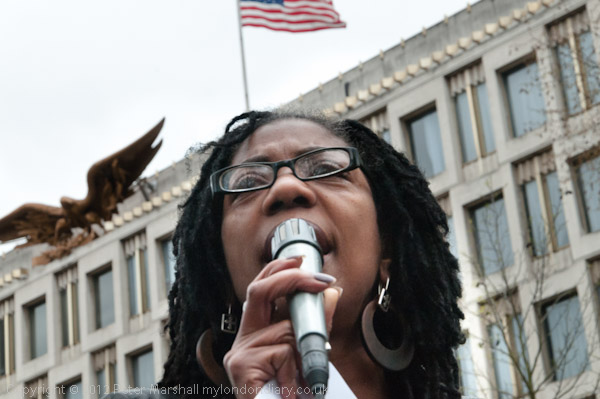 Marcia,
sister of Sean Rigg, killed by police in Brixton police station speaks at
the US embassy protest
Marcia,
sister of Sean Rigg, killed by police in Brixton police station speaks at
the US embassy protest
more pictures
Several hundred protesters, mainly black, gathered at the US Embassy to protest at the failure of the US to prosecuted the killer of Trayvon Martin, a black US teenager shot by a self appointed neighbourhood watchman who claimed he felt threatened by a black teenager wearing a hoodie who had just gone to his local shop to buy a soft drink and some Skittle sweets.
Many of those at the protest came wearing hoodies and carrying packets of
Skittles and soft drinks. The event was chaired by Merlin Emmanuel, brother
of Smiley Culture, killed by police in his own kitchen, and speakers included
Marcia, the brother of Sean Rigg, murdered in Brixton Police Station. She
recounted how police and the IPCC had tried to cover things up, lying about
the presence of CCTV cameras and destroying the CCTV evidence, claiming the
cameras had not been working. Many other cases of deaths and discrimination
against people on grounds of race were also mentioned by the other speakers.
more pictures
Disarm The National Gallery
Trafalgar Square, London. Saturday 31 March 2012
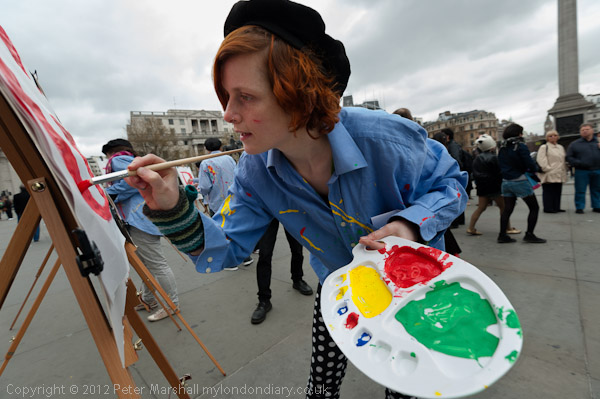
Putting the finishing touches to the'G' in 'Disarm The Gallery'
more pictures
A protest with artists painting in smocks and berets on easels outside the National Gallery in Trafalgar Square called for the gallery to stop hosting events for the arms trade.
The Disarm the Gallery protest was organised by the Campaign Against the Arms Trade (CAAT) and followed a protest they organised there last year during the DSEi arms fair. The biennial fair is the largest arms fair in the world, attended by sellers and buyers from all over the world, including many corrupt and tyrannical regimes, selling the equipment used by dictators around the world to equip armies and police to keep order and fuelling conflicts which kill thousands if not millions. Although the show itself is held in East London at the ExCeL centre, weapons manufacturer Finmeccanica pays the gallery £30,000 for the right to host events inside the National Gallery to entertain its clients.
When I arrived in Trafalgar Square, around 20 'artists', all dressed in blue paint-stained smocks and equipped with moustaches, berets, paint brushes, pallettes and easels with large sheets of paper and a smattering of Franglais were getting ready for the protest. Heritage wardens soon asked them to move up to the North Terrace where they were going to hold their protest.
Easel by easel they moved into position on the pavement in front of the National Gallery, whose main entrance had been closed. First was the artist whose sheet was marked out with the letter 'D' and he started painting it in red. Soon 'I', 'S', 'A', 'R' and 'M' had joined him, and before long were followed by more artists painting the letters for THE and GALLERY.
As well as the artists and those organising their painting, there were also
others present approaching the ppublic and hand out postcards. The protest
did attract the attention of many who were passing by, some of whom stopped
to find out what it was about, and to look at the material on the stall, sign
petitions or postcards to Nicholas Penny, the Director of the National Gallery,
calling on him to end the support of the arms trade. Many of those in the
long queue top enter the gallery through the lower entrance which was still
open were amazed to find that an art gallery was supporting arms sales. As
the postcard says - and people overwhelmingly agreed - Art and arms don't
mix.
more pictures
Stop Harassment At Abortion Clinic
Bedford Square, London. Friday 30 March 2012
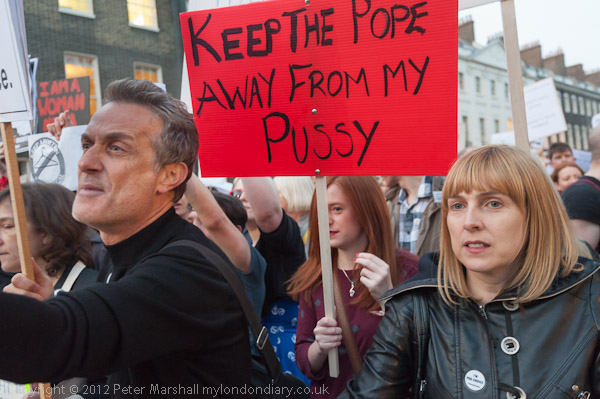 'Keep
the Pope Away From My Pussy' read one placard
'Keep
the Pope Away From My Pussy' read one placard
more pictures
Pro-Choice supporters protested against harassment of women by the Catholic religious group '40 Days For Life' opposed to abortion at the BPAS clinic this evening.
Anti-abortion campaign '40 Days For Life' has been holding a 40 day protest outside the central London Clinic of the British Pregnancy Advisory Service (BPAS) in Bedford Square, standing outside the clinic every day from 8am to 8pm. They stand outside praying and approach anyone entering of leaving the clinic with a leaflet offering advice and support which pro-choice campaigners say gives inaccurate information. They are also said on at least one occasion to have filmed staff and clients.
The national pro-choice campaign Abortion Rights and other pro-choice groups have deliberately not organised any counter-protests during clinic hours, as they feel these would increase the stress on women attending the clinic. The protest at 7pm was chosen to coincide with an evening prayer vigil by 40 Days for Life which is to be led by Bishop Alan Hopes, a former Anglican who became a Roman Catholic in 1994 and is now an Auxiliary Bishop of Westminster, and Westminster Diocesan Youth Chaplain, Fr. David Reilly. Bishop Hopes took part last year in another anti-abortion vigil outside a BPAS clinic in Twickenham with the Helpers of God's Precious Infants, another group like 40 Days for Life inspired by US anti-abortion groups.
I talked briefly with some of a group of four 40 Days For Life protesters in Bedford Square some days ago, and they gave me a copy of their leaflet and told me a little about their campaign. 40 Days for Life began in Texas in 2004 and held its first coordinated campaign in 2007 in cities across the US. Local groups have organised their ninth campaign this spring (the 40 days end on April 1) in 258 locations in the United States, Canada, England, Australia, Spain and Poland. Their web site claims that they have organised in total 1,633 campaigns in 422 cities and that these have led to 21 abortion facilities being closed down, 61 abortion workers leaving their jobs and 5,045 abortions have been prevented.
There were perhaps three or four hundred Catholics at they '40 Days for Life' prayer service, and Bishop Hopes kept himself well hidden in the middle of the crowd throughout. Some of the others at the event were also not keen to be photographed, and hid behind their service sheets when they saw a camera. Even one of the more vocal anti-abortion protesters, who posed for a while holding a placard with a painting of Christ on the cross and the message 'You Took Away Our Sins' was later hiding behind it as other photographers tried to photograph him.
Those at the prayer service were outnumbered by almost two to one by the pro-choice supporters, who kept up a noisy protest throughout, aided by some women bashing on pots and pans and later by a samba band. While the catholics largely stood in silence or quietly made the responses in the service, many fingering their rosary beads and a few continually crossing themselves, many of the pro-choice protesters were in boisterous mood. They had placards protesting against the harassment of women coming to the clinic, and calling for women's right to choose to be protected and warning of the dangers of illegal abortions if legal abortion is made more difficult. Peraps the most popular slogan and chants was 'Keep your Rosaries off my ovaries.'
A large group of perhaps around a hundred cyclists taking part in the monthly
'Critical Mass' protest in central London came and joined the pro-choice protest
briefly. Also present was one man dressed in a black coat and hat and a white
'dog-collar' who had shaved a cross in his dark-haired chest. He described
himself as 'Pro-Love' and wanted everyone to show rather more love for each
other, although like the pro-choice protesters he wanted to see an end to
the harassment of women by the 40 Days for Life campaign.
more pictures
Palestine Land Day: Solidarity For Jerusalem
Kensington High St, London. Friday 30 March 2012
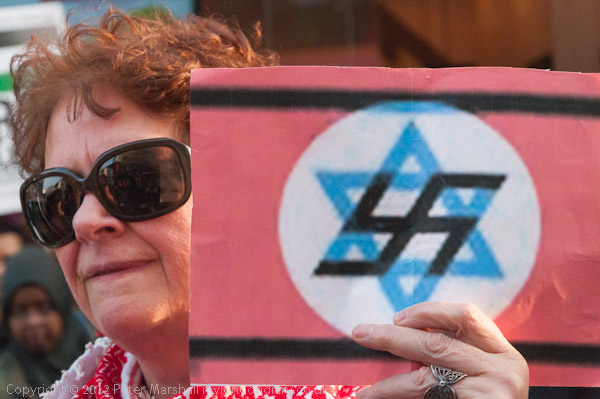
A woman holds up a Star of David with some lines converted to a swastika
more pictures
Around a thousand protested at the Israeli Embassy in solidarity with the Global March to Jerusalem against the destruction of Palestinian life and culture there by Israeli expansion. Opposing them were a small group waving Israeli flags.
The protest was called by the Palestinian Forum in Britain, Association of Palestinian Community, Muslim Association of Britain, Palestine Solidarity Campaign, Stop the War Coalition, Islamic Forum in Europe, British Muslim Initiative, Viva Palestina and Friends of Al-Aqsa and was well supported with many Muslims and non-Muslims crowded behind barriers that stretched over a hundred yards along the pavement.
They were there to show solidarity with the million people who are expected to march towards Jerusalem, and protests were taking place outside Israeli embassies around the world. The march is "in opposition to Israel’s ethnic cleansing, racism and apartheid against Palestinians in Jerusalem. It is an international and multi-faith endeavour, welcoming support from all nations, and all faiths – whether Muslim, Jewish, Christian or of any other religion or none."
Ethnic cleansing in Jerusalem is intended to bring an end to Palestinian life and culture in the city, and is taking place through the demolition of Palestinian homes, building of illegal Israeli settlements, the expulsion of thousands of Palestinians from the city and the removal of residency rights, as well as restrictions and blocking of entry to the city which stops many Palestinians from worshiping in their holy places there.
A huge cheer went up from the crowd when they were joined by the anti-Zionist ultra-orthodox Jews of Neturei Karta. As well as much pro-Palestine chanting there were also a number of powerful speeches, including those of Lindsey German of Stop the War and Jeremy Corbyn MP as well as speakers from Muslim and Palestinian organisations.
When I arrived small group of protesters in a pen 20 yards down the road
were displaying banners with the Union Flag and a St George Cross overlaid
by a Star of David with the text 'British Christians Love Israel'. Later they
all seemed to be waving Israeli flags. Police kept the two groups apart, and
warned a number of demonstrators and photographers but I saw no arrests.
more pictures
Teachers Keep Up The Pensions Fight
Malet St - Dept For Education, Lonedon. Wed 28 March 2012
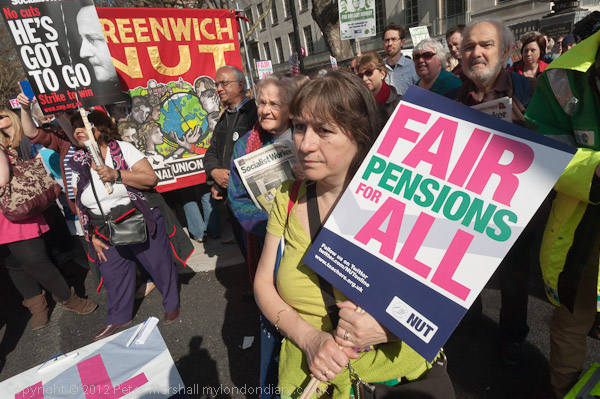
Teachers listen to speeches before the march
more pictures
Around 10,000 school and college teachers, trade unionists and students
marched peacefully across central London today in a protest against cuts in
pensions and public services to a rally outside the Department for Education.
The march formed up in Malet Street, where there were a number of short speeches
including those from other organisations supporting the day's action. Although
this was meant to be the third united trade union day of action against the
cuts, several unions including Unison have suspended strike action, and the
GMB and one of the teaching unions have actually conceded to government demands,
and there were few unions prepared to take action today, although quite a
few rank and file members were there.
The NUT, UCU and PCS ballots gave strong support for a strike today, but the NUT decided to call one for London members only, and the PCS put off calling any action. Despite this there were some PCS branch banners on the march, as well as many NUT groups from outside the capital, and by the time the march was ready to start, the length of Malet St was closely packed with protesters, making it difficult for me to move around, and they were spilling out into adjoining streets.
As the march moved through the West End with numerous banners and placards there was considerable support shown by people on the street, with drivers hooting, people waving and saluting in solidarity and at one point a small crowd stopped and clapped the march for some minutes.
At the front of the march were a group of three women students wearing grey wigs and granny glasses carrying placards 'Teacher of the Future' and 'Now Consider The Future of Education'. Other placards had a large 68 crossed through with the message 'Don't Work Longer & Pay More To Get Less.' The teaching profession has previously reached an agreement with government over pensions, and historically the Teacher's Pension Scheme has over the years been a good earner for the government rather than a burden. Those starting in the profession now, if the government gets its way, can expect not just to be working until they are 68, but well into their seventies. Teaching, as those who have tried it know, is often highly stressful, and can involve very long hours - often well in excess of the legal maximum.
Jeremy Corbyn MP came to speak at the rally before the march, and I photographed John McDonnell MP marching along with Vice-President of National Pensioners' Convention Dot Gibson and former NATFHE General Secretary Paul Mackney (Vice-Chair Coalition of Resistance.)
The Education Activists Network kept up their usual loud chanting throughout the march, and their tactic of coming to a halt behind their banner to allow a gap to develop in front of them before working up into a crescendo before a mad forward rush to close up the gap soon gained them a row of police accompanying them on each side. As expected, they sat down briefly in protest opposite Downing St.
The final rally outside the Dept for Education, which was firmly locked,
in Great Smith St was adressed by a number of speakers including General Secretaries
Mark Serwotka of PCS and Christine Blower NUT, but I missed most of the speeches.
The narrow street was packed for much of its length with the larger than expected
march, and it wasn't possible for most of those present to hear them.
more pictures
Bikes Alive King's Cross
King's Cross, London. Monday 26 March 2012
For once Jenny Jones was without
her bike - but still took part in the protest
more pictures
Campaigning group Bikes Alive held another protest delaying traffic in the evening rush hour at King's Cross, where road engineers were told to ignore cyclists in planning the junction, leading to injuries and at least one death of cyclists.
Around 30 cyclists along with a few campaigners on foot made a number of slow circuits along the Euston Road and the one-way system at King's Cross at the height of the evening rush hour, causing short delays to traffic through the area which soon backed up some way down the Euston Road. Among the cyclists were a few campaigners on foot, including this evening London Assembly Member and Green Party Mayoral candidate, Jenny Jones, a keen cyclist and promoter of cycling safety and facilities for cyclists.
The cyclists were accompanied by three police cyclists, a couple of police motorcyclists and a police car, and shortly after the protest started the police had to wave over several motorists who seemed determined to drive through the bunch of cyclists. At one point one of the police motorcyclists warned some of the cyclists for going through a red traffic light, although as the protest had stopped the traffic and it was being held by police there seemed to be no reason to stop, and to do so would simply have held up traffic on the Euston Road for longer, but otherwise there seemed to be no problems.
Revelations that Transport for London (TfL) under the direction of Mayor Boris Johnson had told road engineers to ignore the needs of cyclists when planning the road layout at King's Cross shocked all those concerned with road safety, and work has begun on changes at the junction there which will actually make things even more dangerous for cyclists. The area was also chosen as the location for the series of protests following the death there last year of cyclist Min Joo Lee, commemorated by a white-painted 'ghost bicycle' with flower tributes at the junction.
TfL's policy is said by campaigners to support the unnecessary use of motor vehicles and to prioritise the speed and volume of motor traffic over the health, safety and ease of movement of the community as a whole. They say that traffic lights are sited and their changes timed to suit the impatience of motorists rather than the needs of cyclists and pedestrians, and that pedestrian crossings are now threatened with removal because they hold up traffic, even where this will make it impossible for disabled people to cross some roads.
Many road planning decisions appear to be based on models of movement which assign high costs to the movement of cars, lorries and other motorised vehicles but ignore the needs of those on foot, on bicycles or mobility scooters and in wheelchairs. Planning is aimed at increasing traffic flow on the roads in a city where more than 4,000 premature deaths each year are caused by pollution, largely from traffic, and vehicle em missions also form an important contribution to climate change. We need policies that encourage walking, cycling and the use of low or zero-emission vehicles and of an improved public transport system to make London a cleaner and safer city.
The most important way to encourage cycling is to take measures to make it safer. Among the ways this could be done would be to have a 20 mph speed limit as the default in urban areas, to redesign dangerous traffic junctions with filters and lights for cyclists, to ban parking in cycle lanes and prosecute drivers who abuse these and other cycle facilities, and to follow the example of some other countries in giving pedestrians and cyclists legal priority over motor vehicles, and in particular insisting that vehicles give way to cyclists and pedestrians at junctions - as happens in some other countries.
This protest was one in a series at King's Cross, and more are expected to
take place later in the year.
more pictures
Olympic Site From Westfield
Westfield Shopping Centre, Stratford. Sat 24 March 2012
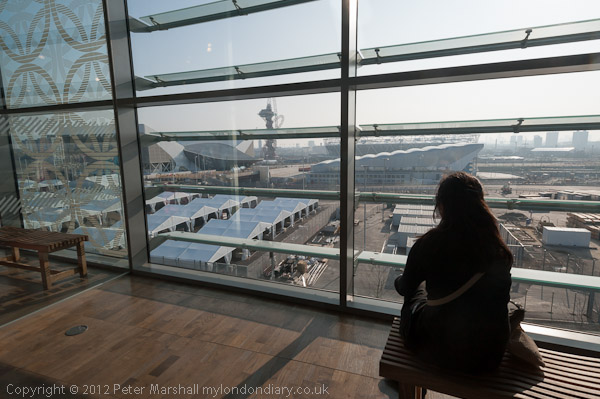
John Lewis has a viewing area and is a good refuge from Westfield
more pictures
Westfield Stratford on a Saturday afternoon is as near to hell as I ever hope to see. But the John Lewis store has a very civilised viewing area overlooking the site where you can buy tea or coffee, and get a good view over the hospitality area and see the aquatic and water polo stadi and in the distance the athlletic stadium and silly tower thing.
Frankly the official viewing area is more of an insult than a facility, offering
a very limited view of the site. Westfield could surely have come up with
something better than this.
more pictures
Leyton Marsh Olympic Protest
Finsbury Square & Leyton Marsh. Sat 24 March 2012
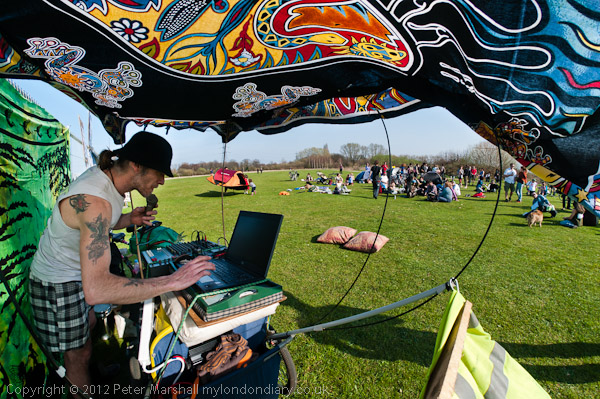
Saturday's protest was a picnic, and a bicycle brought
a sound system with a DJ
more pictures
Local protesters against an Olympic basketball training facility being built on municipal open land were joined today for a picnic and protest on Leyton Marsh by marchers from the Occupy London camp at Finsbury Square.
Local people from Leyton and Clapton who are incensed over the last minute application by the Olympic Development Authority (ODA) to build an Olympic basketball training facility on Leyton Marsh, a well-used and loved area of municipal open land adjoining the Lea Navigation have begun an active 'Campaign to Save Leyton Marsh'.
There are many brownfield sites in the area, as well as a massive recently built basketball facility nearby and they are aggrieved that this open land was chosen and the application rushed through by Waltham Forest Council with no consultation with them.
People, including some in their eighties, have been taking non-violent direct action to prevent the work, stopping lorries and machinery from accessing the site by standing in their way as well as by organising a lengthy game of 'boules' on the driveway that has been laid across the public land to the site. As the land concerned is public open space they do not appear to be committing any offence by walking on it and small groups have been able to effectively prevent access and stop work on the site. As well as direct action the group is also taking legal action and hopes to gain a judicial review of the decision and an injunction to stop the work.
Although the ODA have stated that the three-storey building is temporary and will be removed after the Olympics, they have not made a clear promise to remove the extensive foundations and restore the land to its original condition. The campaigners fear that although the basketball facility may be removed, the foundations will remain and be used for some future 'leisure' development such as a hotel or an extension of the facilities of the nearby Lee Valley Ice Centre, and that this open space will be permanently lost to the public.
It isn't clear why the ODA decided that it needed this practice facility at such a late stage in the Olympic developments, though there is some speculation that some national teams, particularly the USA, may not have been satisfied by the security provisions at a previously proposed practice location. It seems almost certain that the people of the area will be denied any access to a very much larger area than the actual site for the month of the Olympics and Paralympics, possibly including the whole of Leyton Marsh.
The local campaigners were joined today by a group from the one remaining London Occupy site in Finsbury Square, around 20 of whom in two groups marched the roughly four and a half miles there to a picnic next to the fence surrounding the site. Approaching a hundred protesters came and erected a few tents as well as sitting around on the grass enjoying a picnic in the glorious warm sun.
A bicycle brought a sound system to provide some music (which some locals were not entirely happy with), and there were a couple of short speeches about the development and why it was important to oppose it, as well as a report on the actions that the Campaign to Save Leyton Marsh had been taking. Some of the Occupy protesters were hoping to camp on the site to help stop the work restarting on Monday morning.
They were still there over a week later when I put these pictures on line,
and it had also emerged that the work being carried out on the Marsh was rather
different from what the ODA had planning permission for. They had permission
only to remove 8 inches of top soil, avoiding any need for to investigate
any archaelogical or hazardous waste that might be buried below the grassland
before development. They appear to have already excavated to more than 2 feet,
and have submitted a further application to allow this, which has not yet
been considered by the council.
more pictures
STARR Homicide's 9th Anniversary
College Green, Westminster, London. Wed 21 March 2012
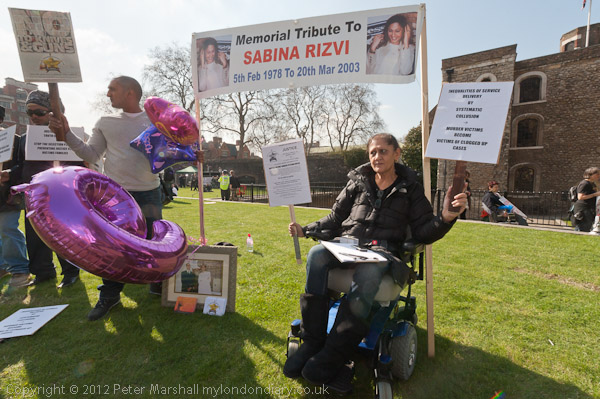
Campaigners with banner, placards and a purple '9' call for justice
more pictures
STARR which campaigns to eliminate guns, support victims of gun crime and to press for justice held an 'Assembly Of Those Seeking Justice For Cold and Unresolved Murder Cases' on College Green on the 9th anniversary of the murder of Sabina Rizvi.
STARR (Sabina's Trust Against Revolvers and Racism) Homicide was established in March 2003 by Bhupinder Iffat Rizvi in memory of her daughter Sabina who was killed after having left Bexleyheath police station where she had gone discuss a car which she had just bought but that the previous owner, a Thamesmead drug dealer claimed had been stolen from him. Around 2pm she left the police station in another car driven by her former boyfriend, a rival drug dealer, through whom she bad bought the disputed car and who later admitted he had stolen it at gunpoint.
The car they were in was followed and ambushed by two other cars, and both Sabina and her former boyfriend were shot several times; he survived but she died at the scene of the crime. The disputed car's owner was later convicted of murder but the others involved have still not been brought to justice, despite the Met Police offering a £20,000 reward for information.
STARR aims to raise awareness over the availability of guns and the consequences of using them, and the painful impact that gun crimes have on families involved. They want the Criminal Justice system to be more responsive to the needs of the families and also to provide support and counselling though in person, telephone and online services.
Around a dozen family members and supporters of the trust came to hold an 'Assembly Of Those Seeking Justice For Cold and Unresolved Murder Cases' and a memorial tribute to Sabina Rizvi on College Green, questioning the role of police, coroners, the CPS and the IPCC. The ask for a proper effort to be made to solve outstanding murder cases, many of which are simply shelved. They say "All we seek is justice" but they are told "There are other things happening in the world, which are more important."
After the tribute opposite Parliament they were intending to light candles
to the memory of their loved ones who have been killed at the Innocent Victims'
Memorial at Westminster Abbey.
more pictures
Justice for Hollie Greig
College Green, Westminster, London. Wed 21 March 2012
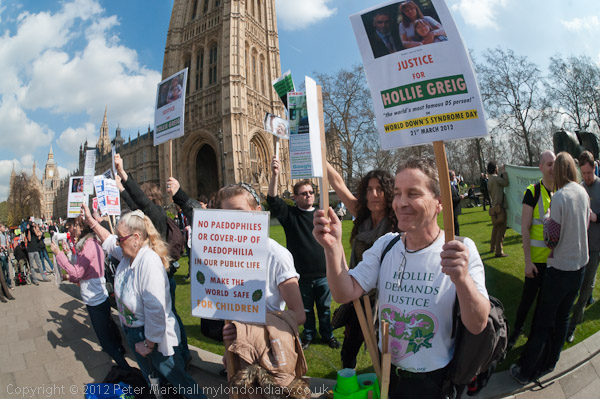
Protesters call for Justice for Hollie Greig on College Green
more pictures
Campaigners for Hollie Greig were protesting on College Green on World Down's Syndrome Day. They want justice over the allegations of her long-term sexual abuse by leading members of Aberdeen society which have led to Hollie and her mother having to flee Scotland and go into hiding.
Many of the details of Hollie's case are well-known, thanks to the very public campaigning of Robert Green on her behalf since 2009 particularly through the web, including a blog and a series of videos. He was arrested and sentenced to a year in jail in Aberdeen in February this year for speaking out - nine months for 'Breach of the Peace' and three months for breaking his bail conditions. The leaflet handed out by the group states:
"the so-called 'mainstream press & media' won't touch it... Hollie knows too much, and is saying far too much about the kinds of people who rule our country.."
They allege that Hollie "was the plaything of a group of these 'secretive' people during her childhood in Aberdeen, Scotland" and that this only came to light when in 2000 aged 20 she found the courage to tell her mother and the police, who although they established through medical examination that she had been the victim of long-term sexual abuse took no action because of the involvement of senior members of the force. They say that there were 7 other known victims of the paedophile ring which "included a judge, care workers, a policeman, an accountant and other leading men and women of Scotland."
Hollie and her mother were threatened and harassed and in 2005 fled Scotland, moving to Shropshire. Here they allege the harrassment continued and when the council threatened to sepearate Hollie from her mother and take her into care the two women went into hiding. Last year in the Royal Courts of Justice Family Division a judge ruled Hollie 'lacked capacity' to make decisions over her future, despite there apparently being medical evidence that she is capable, and this was upheld on appeal early this month in a ruling which appears to mean that local authorities and closed courts can take control over the life of anyone they decide is 'vulnerable' without the need for any evidence or proof.
In November 2009 The Press and Journal in Aberdeen did run a story about the case under the headline 'Hollie tells police she was abused by sheriff' and 'Down's Syndrome Woman Names Paedophile Ring' which outlined the case without giving the names of the two men at the centre of the allegations. They reported that Hollie had received "£13,500 compensation from the Criminal Injuries Compensation Authority" earlier that year and that both Grampian Police and the Crown Office in Edinburgh had written to one of Hollie's supporters confirming that the case was then still under investigation. One of the facts that was revealed during Robert Green's trial was that the police had not investigated or questioned any of those people who Hollie had named as abusers, so it is hard to understand what form these investigations had taken.
The protest has actually gained considerable coverage in the media, and considerable public support, but this has so far resulted in no real progress in investigating the allegations or bringing anyone responsible to justice. The campaigners have attracted a wide range of support including that of various odd conspiracy theorists and right-wing groups along with the more balanced, and a proper investigation would surely be in the public interest.
The campaigners chose to protest on March 21st because it was World Down
Syndrome Day, the 7th anniversary of its first promotion by Down Syndrome
International (DSi), a UK based international charity and the first year is
has been officially observed by the United Nations. They decided to protest
on College Green because they knew that this was the media village for the
TV news coverage of Budget Day. A group of around 20 campaigners protested
vigourously a few yards from the cameras at least for the couple of hours
I was present.
more pictures
Budget Media Village Protest
College Green, Westminster, London. Wed 21 March 2012
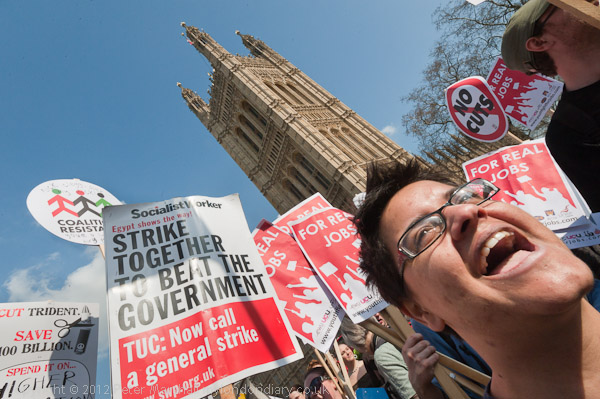
Protesters chant slogans on College Green where the media conduct interviews
more pictures
From Downing St, UK Uncut protesters marched down to College Green opposite the Houses of Parliament from where the major broadcasters report and carry out interviews, and protested there, despite requests to move by the police and Black Rod.
Around noon, having made an 'Austerity Isn’t Working' jobcentre queue at Downing St, many from UK Uncut decided to walk down Whitehall and through Parliament Square to protest on College Green, the area of green space generally open to the public diagonally opposite the House of Lords, where broadcasters often interview politicians. For events such as the budget, they set up open-air studios on the grass.
The protesters wanted to make sure that the broadcasters and viewers and listeners saw their protest against the austerity measures and also against the changes in the health service and welfare reforms. Prominent among those taking part were a group of disabled people, some in wheelchairs, who are appalled at the taking away of benefits, particularly through computer-based assessments which have been shown not to be fit for purpose, which result in many people who are unable to work being classified as fit and losing benefits. Over 70% of those who appeal have suceeded, but the process of appealing is taxing and slow, and many of those who suceed have to attend another assessment within weeks, where there benefit will again be removed.
The Welfare Reform Act which received Royal Assent on 8 March will replace Disability Living Allowance with Personal Independence Payments, which will result in many disabled people losing the current support which enable them to live independently and to continue working.
One man with a mental health problem described clearly his desperation over the future, and the government's reforms are expected to lead to a rise in suicides.
The protesters made another attempt to create an 'Austerity Isn’t Working' queue on College Green, and although it didn't work from ground level, it should have been more impressive from the raised platform of one of our major broadcasters, but they turned their cameras away from the protest.
After a while a police officer came to tell the protesters that they were on private ground, owned by the Palace of Westminster, and that although they did not have the necessary permission (under the Serious Organised Crime and Police Act 2005) to hold a protest in the designated area around Parliament, they would be allowed to continue if they moved the short distance to Old Palace Yard. Although this is opposite Parliament, this would have made their protest invisible (and inaudible) to the TV cameras and the protesters decided unanimously to continue where they were.
Although a part of the Palace of Westminster, College Green is generally open to the public - and was for many years used with no restrictions, and it is only in very recent years that it has been closed off for use by the media on special occasions.
Later, Black Rod himself (though without his rod), Lieutenant-General David Leakey, who is in charge of security for the Lords came out to talk to the protesters, asking them if they would move twenty yards away from the broadcasters. Some of the protesters were willing to move a short distance - perhaps ten yards - but others spoke firmly about not giving an inch and won the day. Black Rod had angered some by at first seeming to ignore the disabled protesters, and some of those present claimed a victory and that he had been chased away.
A small group of protesters from ALARM! (All London Anarchist Revolutionary Mob) provided some entertainment by taking over an empty elevated press stand and posing with their banner and placards, and Ian Bone made a speech saying that they had taken over and had all those Eton Boys (and Girls!) on the run.
By the time I left, more than half of the protesters had already drifted
away and it seemed likely the others would leave soon. Although at one time
I counted three police vans at the far end of the green and another six close
by on Old Palace Yard, the police had not made any physical attempt to clear
the protest and I saw no arrests.
more pictures
Budget Day At Downing St
Whitehall, London. Wed 21 March 2012
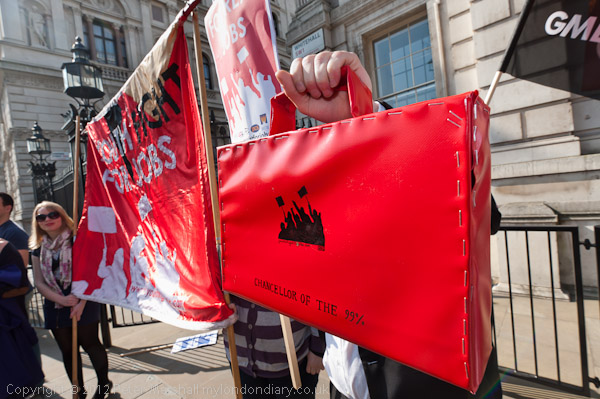
The red bag of the Chancellor of the 99% outside the
gates of Downing St
more pictures
UK Uncut staged an 'Austerity Isn’t Working' jobcentre queue outside Downing St, parodying a well-known Tory billboard, while across the road CND held their Time to Cut Trident protest, supported by the PCS, Coalition of Resistance and Stop the War.
The UK Uncut protest was arranged as a flash-mob, with people and banners appearing on the stroke of eleven o'clock, and appeared to take the police a little by surprise, although it had been widely advertised. Officers kept the actual roadway into Downing Street through the heavy gates and armed police clear, but otherwise did not attempt to move the more than 500 people who were taking part. Organised protests are not allowed on this side of Whitehall, but this could perhaps have been seen as a 'media event' rather than a protest, and different rules apply.
It was immediately obvious that the plan to try and produce a photograph similar to that used in the infamous Saatchi 'Labour isn't working' poster produced for the 1979 General Election was doomed from the start. Although enough people were present, it was difficult to organise them on a busy street, milling with media, tourists and other passers-by - it perhaps could have been done at dawn, but not at 11am. And whoever thought of the idea had apparently forgotten the low walls that now run along the middle of the pavement, which where hiding most of the people behind.
However it was an idea that drew plenty of media attention, although for political reasons it is likely to get more coverage abroad than in the UK, where most protests are suppressed by the news media. We usually have the freedom to protest, but our major news channels largely ignore this aspect of the news unless it involves celebrities, violence or nudity.
After a while standing in line for the photographer to try and take a picture, the people in the queue were invited to file through the 'Unemployment Office' and collect their 'dole', a gold-covered chocolate coin. Many of them then decided to go and continue to protest around the Houses of Parliament.
Across the road in the area designated for protests a smaller vigil was taking
place, organised by the Campaign for Nuclear Disarmament and supported by
other groups including the Public and Commercial Services union (PCS), Coalition
of Resistance and Stop the War Coalition. The held placards and banners around
a large inflatable Trident rocket, pointing out the waste involved in spending
£100 billion on its replacement, particularly at a time of austerity
where huge cuts are being made in public services. The protesters say that
this is is money that could be better spent on schools, on hospitals and on
social welfare rather than supporting the pretence that we have an independent
nuclear deterrent - when it is under US control - and which our military now
regard as irrelevant to national defence.
more pictures
Medmenham Walk
Medmenham, nr Marlow, Bucks. Monday 19 March 2012
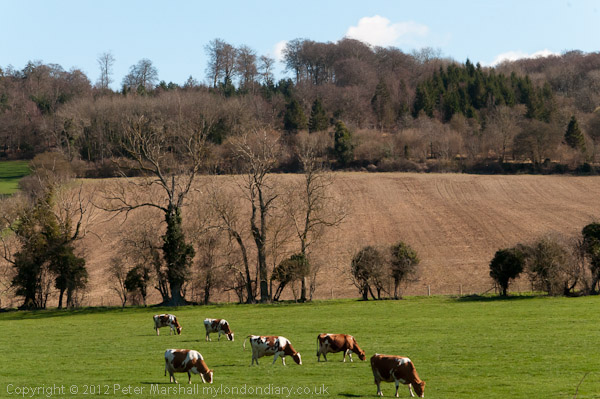
Another walk in the country outside London
more pictures
It isn't London, but it certainly is commuter countryside, at least for the rich, not a huge drive along the M4 to the city - or you can take the train from Marlow. Medmenham also has a surprisingly frequent bus service - as good as any around where I live on the edge of London - with buses every 20 minutes during the day to Reading via Henly and to High Wycombe via Marlow. But I was with family and we went by car, and this was the view from the car park.
We started at Mill End and walked through countryside up the escarpment here and down again to Medmenham, where I went down to the River Thames and then back up to the Dog and Badger pub for a pint of bitter from Marlow's Rebellion Brewery (highly recommended.) We'd hoped to walk further but had to go on to Bracknell for a late lunch.
Medmenham has a couple of oddities, though any remains of the Abbey which
was once the Hellfire Club are inaccessible to the public. In one of the front
gardens of the village are two guns said to be those that relieved the Boer
War seige of Ladysmith, and at the river's edge a monument commorating the
legal victory in 1899 defending the public right of way across the ferry -
which of course like most Thames ferries stopped working not long after -
probably around 1920.
more pictures
Brent St Patrick's Day
Willesden Green, London. Sat 17 Mar 2012
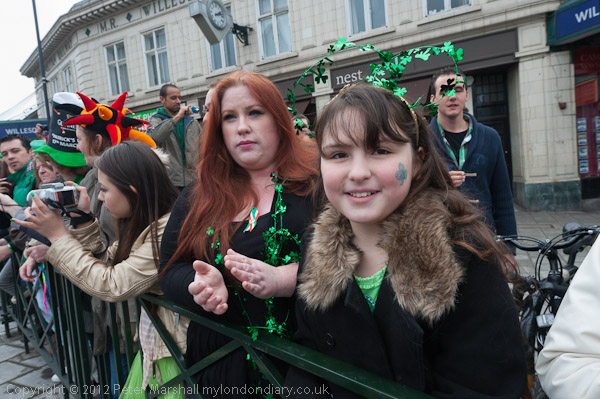
The streets seemed less crowded than in previous years
more pictures
St Patrick's Day was celebrated in London with a colourful procession to Willesden Green library through crowded streets led by the Mayor of Brent and St Patrick.
There were doubts last year over the continuation of the St Patrick's Day parade in Brent following drastic cuts in council spending on community events, but this year the event continued as usual. Always held on the actual day - unlike the mayor's event in central London which takes place on the nearest Sunday - the Brent event held in Willeden Green is very much a local community event, and one that attracts support from the various communities in one of London's more multicultural boroughs.
The event pulls in those of Irish origin from a wider area than the borough, and todays parade included two bands, one from Ireland and the other of Irish bagpipers from Birmingham. After the parade there is a lengthy cultural festival based around the library and a stage outside. The event starts from Willesden Green station, and the short procession goes through streets lined with onlookers - including many who have previously been celebrating the day in various pubs and bars on the route - to the library.
It is on a smaller scale and has a more friendly atmosphere than the main
London celebration. Most years it takes place on a weekday, after the schools
have finished for the day and I had expected there to be more people around
today as it was on a Saturday, but the attendance was lower than in recent
years, perhaps because of the dull and rather damp weather. Among the those
taking part were two St Patricks, one around normal size and the other perhaps
three times as tall, a group of school children in carnival costumes with
an Irish colour schemed and a very large and rather cheeky snake.
more pictures
Asad Supporters Counter-Protest
Belgrave Square, London. Sat 17 March 2012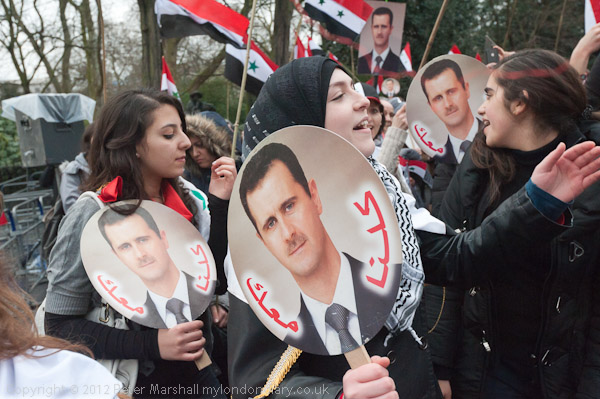
Everyone seemed to have a photograph of Asad
more pictures
The pro-Asad rally was also in a double barriered pen, and was considerably smaller than the Free Syria protest. It seemed more a disco about a personality cult than a political rally of any kind, with almost everyone waving a placard with Asad's photograph on it, and many wearing t-shirts featuring his face. They were playing music at a literally painful volume, hugely distorted through the large speakers, and several times I found myself having to move away from the platform because of the noise.
There were thankfully a few times when the music stopped, and people came
up to lead chants which appeared simply to be praising Asad, though I couldn't
understand much of them. While I was there the only speech was a man advertising
a trip to Syria, who said that on a previous trip they had been able to see
for themselves that the situation in the country was being falsely reported
by the media.
more pictures
Free Syrians March To Embassy
Paddington to Belgrave Square, London. Sat 17 March 2012
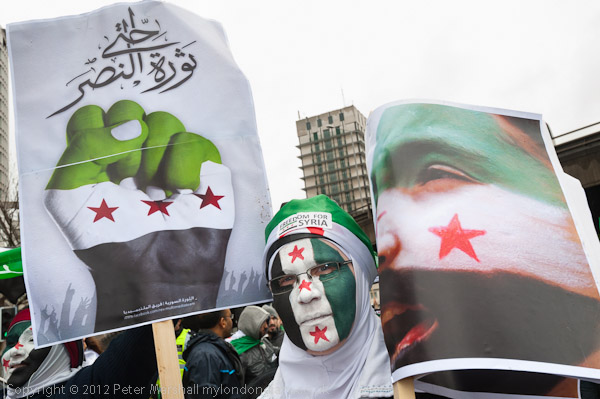 Woman
on the Free Syrian march to the embassy from Paddington Green
Woman
on the Free Syrian march to the embassy from Paddington Green
more pictures
Over a thousand Syrians calling for freedom in their country and an end to the massacres of the Syrian people marched through London to a rally outside the Syrian embassy. A couple of hundred rallied in support of President Asad a few yards away.
The free Syrians had gathered on Paddington Green from noon, and there was a lot of noisy chanting and flag-waving, calling for an end to the attacks on the civilian population in Syrian towns, where the army has shelled whole areas indicriminately before moving into areas, with many reports of atrocities, torture and disappearances. They also expressed support for the 'Free Syrian Army', which includes many who have deserted from the Syrian Army after having been ordered to fire on innocent Syrian people. One woman held a poster claiming that over the year of the Syrian uprising 11,035 people had been killed by Asad's forces, with a map showing the numbers in each area of the country. Others had placards listing the number killed each month, for example: 1119 in Dec 2011, of which 58 were women and 68 childrem
The march began in light rain around 1pm, and I left it as it went down the Edgware Rd towards the Syrian embassy in Belgrave Square, rejoining the protest soon after it arrived there. The large crowd filled a deep pen across most of the north side of Belgrave Square, with a platform erected opposite the embassy itself, and there was a long list of speakers talking about the situation in Syria and expressing support from various other groups for the Free Syrian cause. Next to the platform was a tall tower, a reminder of the tower in the main square of Homs, where huge peaceful demonstrations were put down by force, and where over 700 people, including many women and children were killed in government attacks on the Baba Amr district last month. Along the fence around the gardens were a row of large banners listing some of the many towns where atrocities have taken place, but there were too many people standing in front of them to photograph them. An effigy of Asad hanging from a gallows was carried through the crowd as the speeches continued.
A solid double fence of linked barriers separated the protesters from the
roadway, reduced to a single lane, with police standing in lines outside it,
and there were more police around the whole area - even some with motorbikes
parked on street corners almost half a mile away, as well as police vans scattered
around. The police precautions seemed sensible as a group of Syrians supporting
President Bashar al-Assad were holding a rally only a short distance away.
Between the two groups was a police-only area of around 50 yards that I had
to walk outside.
more pictures
Frack Off Big Oil!
Swiss Cottage, London. Wed 14 Mar 2012
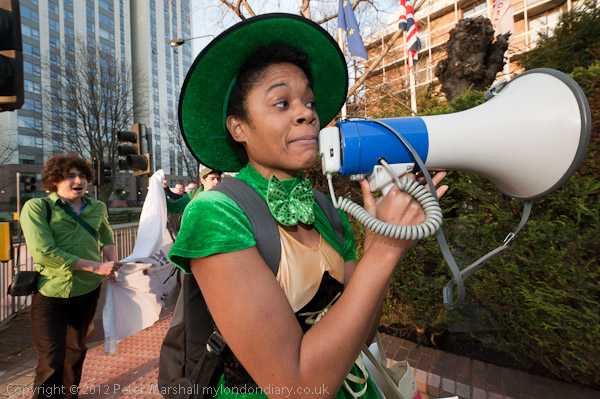
A leprechaun led the protest, two days before St Patrick's Day
more pictures
A protest outside the Unconventional Gas industry conference involving all the major oil companies made clear their opposition to shale oil fracking in the British Isles, including Ireland, because of its dangerous and unpredictable consequences.
Around 20 protesters met at Swiss Cottage station in north Londonand marched the short distance to the hotel where the conference was being held with a large banner reading 'FRACK OFF'. The Unconventional Shale Gas conference involved participants from BP and other major energy companies. The protest was led by a leprechaun both because it was taking place close to St Patrick's Day and because because the oil companies want to begin fracking in Ireland.
Fracking is short for hydraulic fracturing and injects several millions of gallons of water, sand and toxic chemicals under high pressure ito the shale beds to break up their structure and thus release the trapped shale gas. It causes a whole range of environmental problems and has been banned in some countries including France and some US states because of this. There are many well documented cases of contamination of groundwater - and some cases where tap water in homes has contained enough dissolved gases for flames to come out of the taps. One of the slogans chanted by the protesters was:
Flaming water from our taps,
We won't take that kind of crap.
The water has also been polluted by the chemicals added to the fracking fluid, which have included known carcinogens and neurotoxins incluing benzene, lead, glycol, boric acid and 2-butoxyethanol. Radioactive tracers are also often used and many of these including iodine-131 have been detected in drinking water and in milk from areas in which fracking has been used. US studies include reports of many animals as well as humans being affected by these chemicals, including the deaths of hundreds of cows and birth defects and stillbirths of calves. Another slogan chanted was "Shale gas kills, no more deals."
The oil industry has employed various strategies to keep these effects hidden, including refusing to disclose the actual chemicals used in fracking, sponsorship of various US universities to produce biased research studies and political lobbying on a huge scale. Minor tremors have occurred in Lancashire were some fracking has taken place in the Bowland shale.
Destroying the rock structure has also resulted in local earthquakes in the United States, Japan, and Canada, including one substantial quake in Ohio in 2011. The effects are both unpredictable and irreversible - as the protesters chanted "once you frack you can't go back!"
Fracking and the use of the gases produced in fracking also leads to emissions of greenhouse gases and other volatile organic compounds that result in high levels of ozone. Both directly and by diverting funding that would otherwise have gone into renewable energy research and production, fracking will speed up climate change.
Police directed the protest to a pen they has set up a few yards down the road and on the opposite side from the entrance to the Marriott Hotel Regents Park, but the protesters declined to enter it. After some argument the police finally pushed them into the pen. They then walked out and protested across the gateway to the hotel for some minutes, before police pushed them back across the road. Fortunately the traffic stopped, despite the police having failed to stop it. The protest continued for some time and eventually the police pushed the protesters back to the pen. They marched out again for a short walk down the road and back in front of the hotel before being again pushed across the road and into the pen.
It wasn't clear why the pen had been set up where it was, as there was a perfectly good site more clearly opposite the entrance a few yards to the west, but police were insistent that the protesters should use the pen and at this point warned them they would be arrested if they moved out of the pen again. The protest had been continuing for around half an hour at that point, and the protesters decided they had made their point and left.
I was interested to learn from two of the officers at the protest that their
briefing for the event had included information about fracking.
more pictures
Students March Against Fees
Malet St to Victoria St, London. Wed 14 March 2012
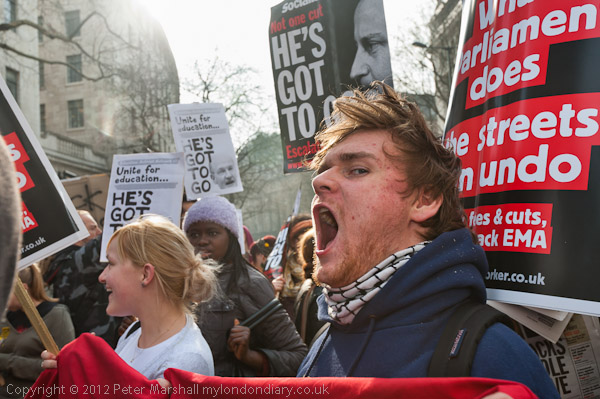
Students shout slogans as the march reaches Aldwych
more pictures
Around a thousand London students marched to the Department of Business, Skills and Innovation calling for Universities Minister David Willetts to resign and in support of Alfie Meadows.
The London march was part of a national day of walkouts called by the National Union of Students and was organised by the Education Activist Network along with various student unions.
Students gathered at the University of London Union in Malet St and marched in an orderly fashion to Westminster. They were accompanied by a large number of police, including many police in pale blue bibs with the legend 'Liason Officer' who were talking to students and handing out information leaflets about the march.
The march stopped for a few minutes outside Downing St, where they sat down on the roadway. Clare Solomon called for everyone to support Alfie Meadows who is being prosecuted following the attack on him by police at the student protest on 9 Dec 2010. After a blow to his head by a police baton, his life was only saved after hours of brain surgery, and apparently he was sent away from the first hospital to which he was taken as that was being reserved for police casualties. He is now being charged - along with many other students - on two counts of violent disorder. More than 12 times as many students as police were injured in the protest. Also speaking was Sean Rillo Raczka, recently elected as ULU President for 2012/3.
After a few minutes halt at Downing St the march continued past the Houses of Parliament to the Department of Business, Skills and Innovation in Victoria St, where it stopped for a static protest. Students shouted up at the windows for Minister David Willetts to show his face in vain, and they called on him to resign because of his disastrous policies which favour students from better-off families and force universities into greater competition with each other. Some universities are expected to have to close, private companies will become increasingly involved in pubic education - and profit greatly from it while students face a lifetime of debt.
People were beginning to drift away when a small group of clowns engaged
in some street theatre aimed at the branch of the HSBC opposite the ministry.
At first they bowed down on the floor outside the door of the bank (keeping
a foot or two back from the police line in front of it) and then moved on
to one of the cash machines in its wall. Finally they sat on the ground in
front of it and burnt a five pound note.
more pictures
London Diocese Celebrate Fairtrade
St Paul's Cathedral, London. Sun 11 March 2012
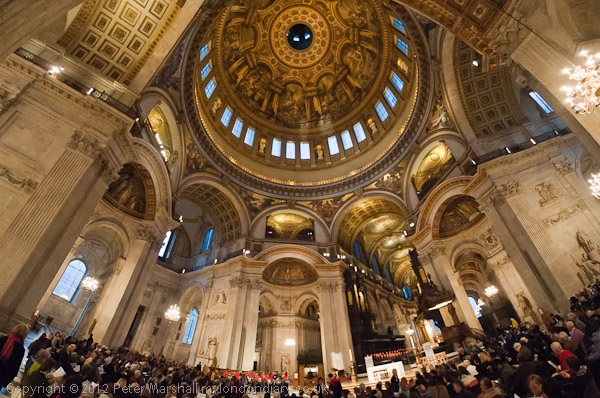
Under the dome of St Paul's - most of the congregation
was elsewhere in this very large cathedral.
more pictures
The Bishop of London, Richard Chartres, and a handful of other bishops (all of course male), along with clergy and congregations from across London came together with invited guests including Fairtrade producers to celebrate the award of Fairtrade status to the diocese of London.
Photography during the service was restricted, and I had to work from a single position using available light, but afterwards I was able to move around and photograph the events freely.
These pictures will be of most interest to those who were involved, although
the Bishop of London received considerable press coverage shortly after this
event as one of the favourites to suceed the current Archbishop of Canterbury
who announced he intended to step down.
more pictures
Holi Festival, Twickenham
Orleans House, Twickenham, London. Sat 10 March 2012
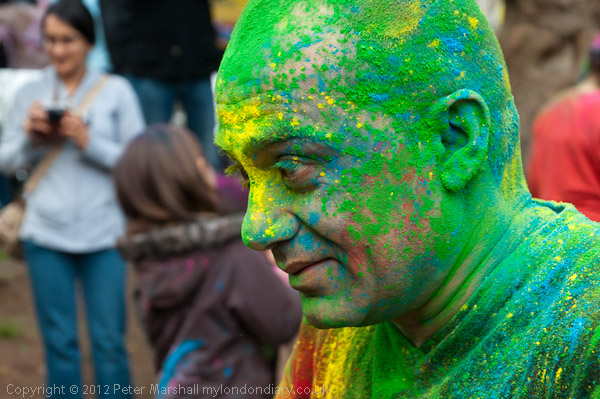 Some
people were seriously covered by the coloured powders
Some
people were seriously covered by the coloured powders
more pictures
Around 10,000 people were expected to attend the Hindu spring Holi festival, also known as the Festival of Colours, in Twickenham, West London. A large crowd watched various Indian performers on the stage and threw colored powder over each other.
This community event in the gardens of the council-owned Orleans House Gallery has apparently been celebrated in the London Borough of Richmond for many years and is a popular event among residents of all communities. It's very much an occasion to let down ones hair and dance and have fun - and to get totally plastered with colour over your face and clothes. Fortunately most of it brushes or washes off easily and doesn't stain permanently, though I did have to soak the jumper I was wearing for several days to completely remove it.
On the stage were various live performances of a wide range of Indian music and dance including Bollywood and bhangra. Traditionally, Holi is a time when barriers are broken down and men and women of all ages and all castes mix and celebrate together, and it certainly seemed to be bringing everyone together today.
The festivities, which are organised by Richmond Council together with the
Ethnic Minorities Advocacy Group and Twickenham Town Business Association
start in the centre of the town, where there is also an Indian market in Church
St, and then continue in Orleans House gardens, and I made my way along by
the riverside to join them there. As well as the paint-throwing and entertainment
there were also a number of stalls selling Indian food, and I was sorry that
I had already eaten on my way there.
more pictures
Stop Namibia's Seal Slaughter
Chandos Street, London. Sat 10 March 2012
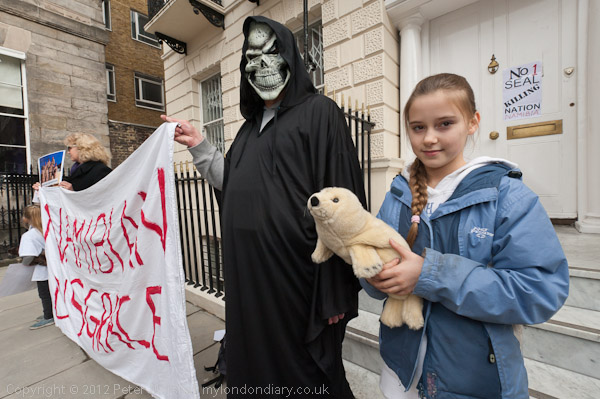
Protesters on the doorstep of the Namibian Embassy
with seal and banner
more pictures
Conservation group Earthrace protested outside the Namibian Embassy in London calling for an end to the annual slaughter of seals in Namibia, 'Africa's best-kept bloody secret', the largest scale and most brutal taking place in any country.
Earthrace came to protest outside the Namibian embassy because the quota there allows 5000 adult bull seals to be shot and 85,000 seal pups to be clubbed to death each year. The blood-covered beaches after the early morning culls are cleaned up by bulldozers before the tourists arrive later in the day to see the seals.
The argue that seal populations control themselves naturally and that culling is not needed, neither is the amount that it earns significant in the Namibian economy. The facts speaking against the argument that seals damage the fishing industry; neighbouring South Africa banned seal harvesting in 1990, and the seal population has not 'exploded' as feared and the fishing industry has actually grown.
The Namibian Minister of Fisheries has stated that he is considering raising the quota "to 'create employment'." Earthrace state that the current harvest only 'employs around 81 badly paid local people on a seasonal basis', a totally insignificant number compared to the 38,000 more jobs in tourism expected between 2010 and 2020.
Allegations that the harvest is carried out in ways that break various rules and regulations are under investigation by the official Ombudsman for Namibia.
The protesters held a banner and posters outside the Namibiam embassy. Some of them also had photographs of seals and toy seals. They called for an immediate end to the brutal, bloody and unnecessary slaughter of seals.
Earthrace Conservation Organisation was founded by New Zealand environmentalist
Pete Bethune, named after the renewable biofuel powered boat with which he
broke the record for circumnavigation of the world in 2011. The boat was later
rammed by a Japanese whaler in an action against whaling in the Southern Ocean
Whale Sanctuary. Earthrace is a world-wide non-profit organisatin that focusses
on marine conservation issues, and has already helped change to law to protect
sea turtles in Trinidad and are involved in various other campaigns in the
Faroe Islands, Mozambique, Australia and elsewhere.
more pictures
Republicans Protest BBC Pro-Monarchy Bias
Broadcasting House, Portland Place, London. Sat 10 March 2012
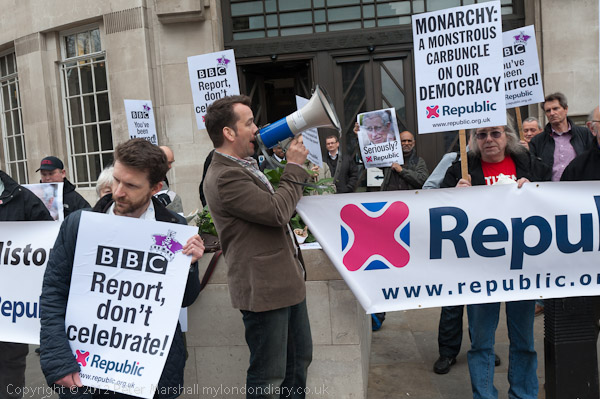 Republic
protesters with banners and placards at Broadcasting House
Republic
protesters with banners and placards at Broadcasting House
more pictures
Protesters from the group 'Republic' protested outside Broadcasting House this morning against the pro-monarchy bias of the BBC, which they say behaves as an extension of the Royal Publicity Office rather than exercising its proper journalistic function.
The group say that the BBC is failing in its duty to be impartial, and that even many of the BBC's own staff consider their coverage of the monarchy and royal events "to be deferential, frivolous and devoid of journalistic standards. It aims to celebrate and promote the monarchy, rather than present the facts about it." Last year's endless reporting of the royal wedding made their point forcefully.
They made four clear demands, one in particular related to an Andrew Marr program which appeared to be completely biased in favour of the monarchy and more generally that the BBS should report rather than promote the monarchy. They want the BBC to treat the monarchy as a "controversial subject", presenting arguments for and against it, and call for the role of 'royal liaison officer' to be scrapped as they say it "suggests and inappropriately cosy relationship between broadcaster and palace."
They want the BBC to report on the monarchy - and on the forthcoming Jubilee celebrations, but like many of us would like to avoid the kind of wall to wall obsequies that we saw for last year's royal wedding. We should be able to celebrate (at least those of us who want to celebrate) without having to suffer such interminable media sycophancy. It devalues these events for all of us.
Around 50 supporters from 'Republic' held banners and placards in front of
the main doorway of Broadcasting House, chanting various slogans, and there
were several short speeches. Most of the posters made their point clearly
through text such as 'BBC You're Not the Palace PR Machine!' but one showed
a photograph of Prince Charles with the caption 'Seriously?' I left after
around half an hour as nothing more seemed likely to happen.
more picture
Swaziland Vigil
Buckingham Gate, London. Sat 10 March 2012
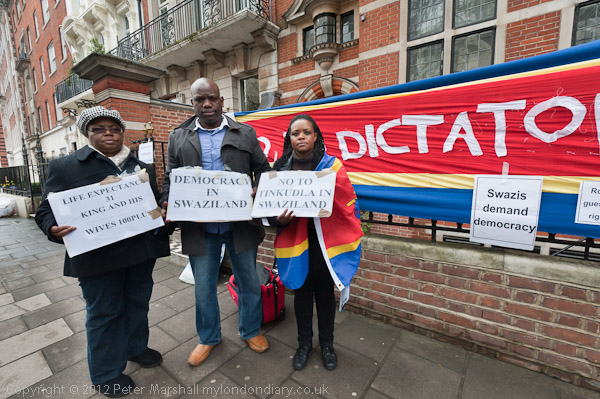
Not many had arrived for the vigil when I called in
more pictures
A regular protest outside the Swaziland High Commission in London pointed out the human rights abuses ande corruption there and called on the UK to cancel all invitations to King Mswati III or other leaders to state visits and occasions such as this year's Jubilee celebration.
Swaziland, Africa's last remaining absolute monarchy has the world's longest running state of emergency - 35 years. Its parliament is based on a system of cheifdoms (Tinkudla) and the King appoints a majority of the members of the more powerful Senate. Independent from the UK since 1968, a new constitution in 2006 affirmed the King's powers including the right to overule parliament.
The main political party is the People's United Democratic Movement, PUDEMO, which was formed in 1983 and immediately banned under the Suppression of . The last elections held in 2008 were condemned as undemocratic by Commonwealth and Pan-African observers. A coalition of pro-democracy groups formed by the unions, churches and political parties in 2008 was described as "terrorist' by the King.
The King has a personal fortune of over US $200 million, while 69% of the people live on less than US $1 a day, and unemployment is over 30%, often twice this among young people. The country has the highest incidence of AIDS of any country, with 1 in 4 Swazis living with HIV/AIDS. Life expectancy for most of the people is very low at 31 years, but perhaps three times as high for a wealthy elite.
ACTSA, Action for Sourthern Africa, the successor organisation to the Anti-Apartheid Movement, supports the trade unions and other organisations in the country who call upon the government of Swaziland to move towards a democratic state, allowing normal political activity, work for a fairer distribution of national wealth and initiate a proper programme to deal with HIV/AIDS.
They contrast the silence of the UK and EU to Swaziland with the opposition they have voiced to the Zimbabwe regime. In a report on their web site they say that the continuation of normal relations with Swaziland and the failure to voice any criticisms or call for action effectively condones the abuses occuring there - incuding the murdering, torture and rape of activists and other abuses. Women in particular suffer from human rights abuses.
The embassy is just a stone's throw from Buckingham Palace, and those taking
part in the Swaziland Vigil held there every Saturday morning since 31 January
2010 are particularly incensed at the invitations from our royal family to
King Mswati III.
more pictures
Tibet Freedom March
Downing St to Chinese Embassy, London. Sat 10 March 2012
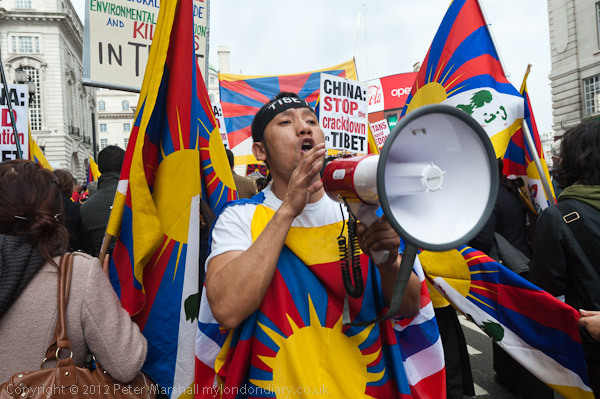
The march goes through Piccadilly Circus towards the
Chinese Embassy
more pictures
The annual Tibet freedom march in London commemorated the 53rd anniversary of the Tibetan National Uprising, with around a thousand people, including many Tibetans and supporters protesting at Downing St before marching to a rally at the Chinese Embassy.
As on previous years, this was a noisy and colourful protest, with many carrying or wearing the Tibetan Freedom flag. At the front of the procession a man carried a photograph of the Dalai Lama, while another beside him chanted. Four women followed, carrying a large Free Tibet flag horizontally. Behind them one man beat on a large drum and over twenty people marched carrying posters with the names and pictures of protesters who have set fire to themselves in protests in Tibet; most have died but some are still in hospital. Then came the main banner '1950: Tibet Occupied By China - Free Tibet Now', followed by a dense crowd waving flags and chanting.
Tibet was an independent coutnry with its own government, postal system, languages, laws and treaties with foreign governments - including Britain - until 1949/50 when China invaded. Since then over 1.2 million Tibetans have died as a result of the occupation and thousands have been imprisoned and tortured for their political and religious beliefs.
Tibet's political and spritual leader, the Dalai Lama, escaped to India with 120,000 others in 1959 and established the Tibetan Government in Exile. Among those held in prison by the Chinese in Tibet is the Panchen Lama, named by the Dalai Lama in the traditional way when he was six in 1995 and imprisoned shortly after. The Chinese drew the name of another young boy out of a Golden Urn and recognise him instead as the Panchen Lama.
The protesters want Tibet to be free and in charge of its own destiny again, calling for an end to the illegal Chinese occupation. They see China developing TIbet as a police state and increasing the Chinese occupation of their country.
China's huge economic power has led western countries to adopt what they have called a policy of 'constructive engagement' with China, which has effectively meant them turning a blind eye to the occupation and to human rights abuses in Tibet.
I left the marchers shortly before they arrived opposite the Chinese Embassy
in Portland Place where they were to hold a rally.
more pictures
London Fairtrade Diocese
St Paul's Churchyard, London. Friday 9 March 2012
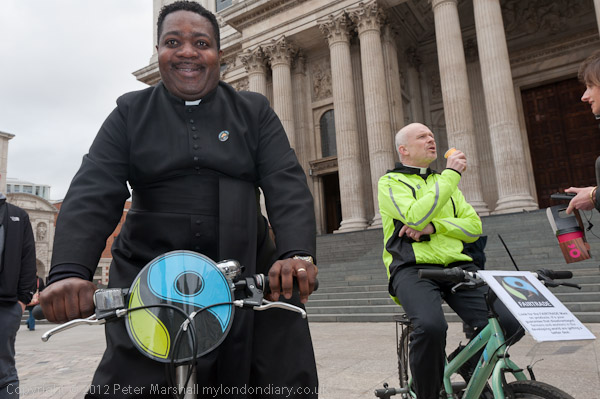 The
bikes powered blenders to make fruit into 'smoothies'
The
bikes powered blenders to make fruit into 'smoothies'
more pictures
An event outside St Paul's Cathedral celebrated the fact that the Diocese of London now has 'Fairtrade' status, with most of the churches in the diocese using fairly traded tea, coffee and other goods. The fairtrade movement aims to give the farmers who grow these things a proper share of the profits made by selling them, which usually go disproportionally to the importers, processers, retailers and others in the supply chain.
The producers use the extra income they get for various social projects, and investment in bicycles is often a part of this. Bicycles can be used to carry heavy loads; they can be used as rickshaws and ambulances, to turn machinery and generate electricity. They are cheap to run and easy to repair.
One of the two bikes in the picture had a blender fixed to the rear rack,
with a wheel against the rear tyre giving a direct drive, and the other had
the rear wheel resting on the shaft of a small generator, with a lead taking
the power to a box the blender was connected to. People seemed to enjoy pedalling
to turn the Fairtrade fruit and orange juice into fruit smoothies which they
could then drink. Many of those who came for the event were the clergy from
the churches in the diocese, and among them was the Bishop of London,
Richard Chartres, but there were also a steady stream of tourists who
came to take an interest and have a free smoothie.
more pictures
Women on the Bridge: International Womens Day
Millennium Bridge to Festival Hall, London, Thursday 8 March 2012
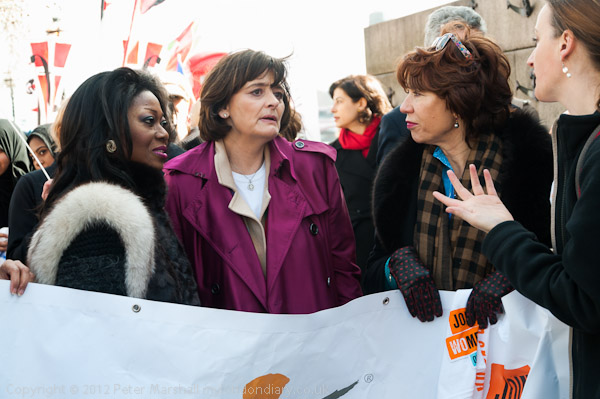
Cherie Blair and others at the front of the march
more pictures
Around a thousand women marched behind celebrities including Cherie Blair across the Millennium Bridge, along the Embankment and back across Hungerford Bridge to a rally in the Royal Festival Hall calling for equity, equality and peace on International Women's Day.
Organised by Women for Women International and Soroptimist International, this was one of a number of events around the world, in what claims to be the world's biggest women's rights campaign. The Women on the Bridge campaign began in 2010 after women from the war-torn countries of DR Congo and Rwanda met on a bridge connecting their countries, "to build bridges of peace and hope for the future."
Women gathered on the riverside outside Tate Modern, where some were making banners and placards for the march, though most brought theirs with them. There were a wide range of women's groups represented, from Soroptomists to schoolkids, including a very lively group who had come up with their teachers from Deepdene Brighton. Trade unions were well represented, with the CWU, SERTUC Women's Rights Committee, Also present were groups supporting victims of domestic violence, the Royal College of Midwives, Royal College of Nursing, East London Feminists, and humanitarian groups including Restless Beings and Hagar.
Unfortunately most of the press were held back by security and missed the release of doves from the Millennium Bridge to which they had been invited. Everyone taking part in the march was given a biodegradable white balloon and told to release it with a wish; some did so on the Millennium Bridge but others kept theirs until the end of the march.
This is one of two large-scale celebrations of International Women's
Day in London, along with 'Million Women Rise'.
Neither seems to reflect the socialist genesis of this day, established by
the Second International in 1910 and held for the first time the following
year. It gained wider support following the suggestion of the UN General Assembly
in 1977 of March 8 as the UN Day for women's rights and world peace.
more pictures
Doctors & Students NHS March
Malet St - Westminster, London. Wednesday 7 March 2012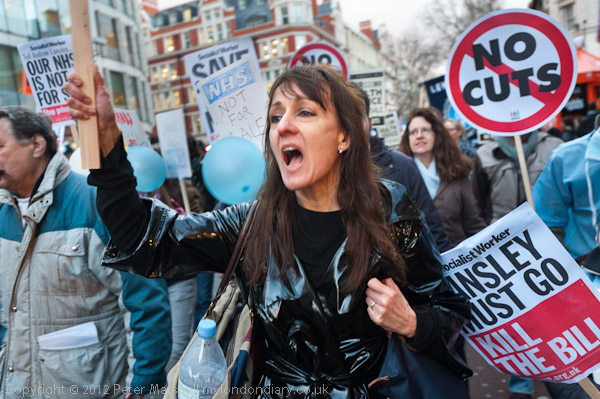
'No Cuts ... Lansley Must Go - Kill the Bill' marchers
on Southampton Row
more pictures
Students marched to the BMA headquarters where they joined a march of doctors, consultants and others opposed to the measures in the Health & Social Care Bill to march to Westminster, where Unite was holding a rally.
Fortunately the rain had finally stopped by the time I arrived at Malet St where the students were gathering outside the University of London Union. There I found that they were to unite with doctors and others who were marching from outside the British Medical Association HQ in Tavistock Square, so the march set off going away from Westminster to join them.
At the BMA there were several hundred more people waiting to march, and they set off shortly after they were joined by the students.
The marchers were disappointed to find the doors of Westminster Central Hall where the Unite rally was in progress closed against them. Most of those taking part had not registered for the rally. After around ten minutes someone came out from the hall and announced that those who had registered in advance would be admitted shortly, and then if there was still space others might be allowed to enter. But by this time many of those who had marched had already left.
It did seem disappointing that there had not been better coordination between
Unite and the other groups taking action over the bill, both over the events
earlier in the day but particularly over the rally. It would have been better
if Unite and the march organisers had arranged for the meeting inside the
hall to end with a final short rally outside when the marchers arrived (or
to start later after a short joint rally outside.)
more pictures
NHS Not For Sale Lobby
Houses of Parliament, London. Wednesday 7 March 2012
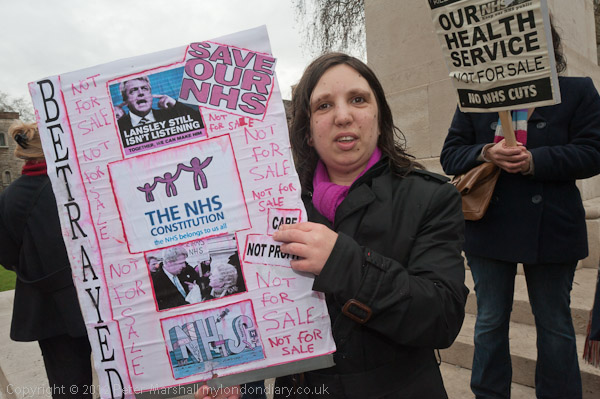 Protesters
with placards in Old Palace Yard
Protesters
with placards in Old Palace Yard
more pictures
Protesters queued in the rain to lobby MPs over the Health & Social Care Bill which they claim will lead to privatisation of the health service and an edn to the NHS. Police tried to move banners across the road.
After lunch I returned to Westminster, just as the rain which had slackened off a little decided to step things up again. There was a long queue of people waiting in the rain to enter Parliament and speak to their MPs and a small group protesting on the yard opposite.
A few of the protesters tried to display their banners outside parliament, and police attempted to make them take the banners across the road, though a few resisted and kept up their protest. Protesters with placards had to leave these outside when then went in for the lobby.
A group of Unite members also arrived to lobby over the NHS bill, but they
were better organised and formed their own queue and were taken in almost
straight away, presumably by previous arrangement. It soon began to rain more
heavily again, and I decided to go and view an exhibition I wanted to see.
more pictures
Save Our NHS Human Chain
St Thomas's Hospital, London. Wednesday 7 March 2012
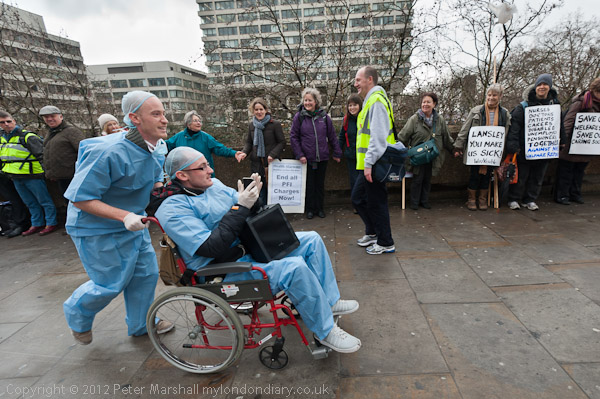
A wheelchair pushed at some speed past the human chain
more pictures
Protesters came on a wet lunchtime to form a human chain around St Thomas's Hospital opposite the Houses of Parliament in a protest against Andrew Lansley’s Health and Social Care Bill which paves the way for wholesale privatisation of the NHS.
As I reached the A&E Department of St Thomas's, the steady light rain turned to a downpour, and I stood inside a bus shelter for some minutes before going to find out what was happening. I was told that people were assembling on the path by the River Thames alongside the hospital, so I made my way there. It was still raining hard when I arrived, but a few protesters were beginning the protest, and for the next ten minutes or so I took photographs one-handed, holding an umbrella with the other which occasionally featured in the top of my pictures.
Fortunately the rain which had been coming down all morning slackened off a little, and then we even had a few minutes when it stopped and the sun came out. More protesters turned up an a human chain began to form, reaching from the hospital entrance on Westminster Bridge Rd along and down the steps and several hundred yards along the embankment path. Forming a human chain around the whole hospital was always an ambitious target, and the bad weather doubtless put many off from coming.
The down came the rain again, and I stood under another bus shelter, and
when the bus came got on it to go elsewhere for lunch.
more pictures
Greeks Protest With OccupyLSX
St Paul's Cathedral Steps, London. Saturday 3 March 2012
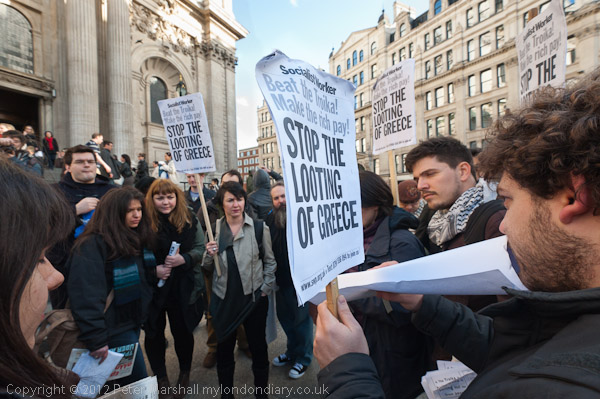
Greeks protest against the austerity measures outside
the cathedral
more pictures
Greeks and supporters of their protest against the austerity measures met on the steps of St Paul's Cathedral, where one of them spoke to a meeting of Occupy LSX that was taking place, and they discussed further protests.
As protests continue in Greece over the terms of the Eurozone rescue package for the country, Greeks and supporters in London met to show solidarity with the students and workers there. They argue that rather than deal with the failures of the financial system and the way that the banks were allowed to profit massively through unsafe practices the austerity program supports the banks that created the problem by making the people pay to bail them out.
The Greek economy is shrinking by around 7% year on year and unemployment, homelessness and suicides rising fast. While the rich are able to protect themselves many ordinary people increasingly find life impossible. The minimum wage has been cut by 22% and many now rely on soup kitches on the city streets to keep alive.
Greece, widely seen as the cradle of democracy, is now ruled by an imposed technocratic government and there are calls for April's general election to be postponed. The two major parties, including the socialist party, have been riven as leading members leave or are expelled over their opposition to the cuts, and support has grown for parties and groups on both the left and also the right.
Left wing groups across Europe and more widely see the struggle of the Greek people against the austerity measures as a leading part of their own fight against the increasing world domination by the financial institutions and the rich, and against the cuts in public services and attacks on the welfare state and human and civil rights in their own countries, including the UK.
Greeks protesting at the embassy last Saturday had decided to protest today at the Occupy London camp at St Paul's Cathedral, and although this was cleared early on Tuesday morning, I was surprised to find a general meeting of OccupyLSX was still taking place there this afternoon. After spending some time discussing the role of the police in society, this then moved on to planning further events, possibly a major protest on May Day or May 15, the anniversary of the start of last year's protests in Spain.
They interrupted the discussion to hear a short address by one of the Greeks about the situation there, and then passed a motion of solidarity with the Greek strikers against the austerity measures.
The Greek protesters, who had displayed placards and banners in a protest on the steps of St Paul's Cathedral then held their own meeting at the bottom of them, discussing how best to continue their protests in London, and in particular whether they should continue at the Greek Embassy or protest elsewhere. The discussion was continuing when I left.
Million Women Rise March
Oxford St, London. Saturday 3 March 2012
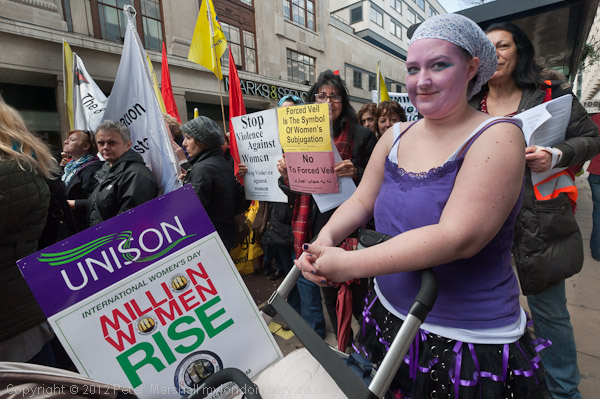
Marchers wait for the march to start in Orchard St
more pictures
More than a thousand women marched through the centre of London calling for an end to domestic abuse, rape and commercial sexual exploitation. They called for prevention of abuse and support and protection for women.
Around a thousand women had gathered in Orchard Street when I arrived for the start of the march, coming from various womens groups and organisations around the country for this all-women march calling for and end to male violence against women.
Conspicious by their absence were some of London's more active women campaigning groups, including those that have been the leaders in previous celebrations around International Women's Day. Earlier in the day I had been shocked to be told by a woman from one of these groups that they had been told they were not welcome at this march, despite the coalition's aim to be non-partisan and to bring "together women who want to highlight the continuation of all forms of violence against women and demand that steps are taken to put an end to this." There were a number of political groups from London's ethnic communities present, including Kurds, some in traditional dress and some holding posters calling for the release of their leader Abdullah Öcalan from prison in Turkey, as well as groups opposed to the Iranian regime. The march was going to a rally at Trafalgar Square, but I had to leave it at Bond St to attend another event.
The Million Women Rise Coalition is gather signatures for a statement of demands for government and societies here and around the world, demanding that they recognise and reflect in policies the discrimination faced by all women and those from black and other minority groups in particular. They demand that domestic abuse, rape and commercial sexual exploitation are linked together in a definition of violence against women and that support is given to support organisations for women in the not-for-profit sector.
Their statement also calls for support of the demands by the End Violence Against Women Coalition (EVAW) and End Child Prostitution, Child Pornography and Trafficking of Children for Sexual Purposes International Forum (ECPAT) for the protection of children and the abolition of the ‘no recourse’ requirement for abused women who have insecure immigration status. They also call for proper support for trafficked women and children.
They want to change public attitudes through education initiatives and campaigns and for International Women’s Day to be made a Bank Holiday in the UK and Ireland, and oppose "the continued misrepresentation, misappropriation and abuse of the female body throughout all forms of media."
The statement also makes clear that wars and conflicts around the world perpetuate
violence against women. Among those marching were a group of Tamil women with
a banner reading 'Raped, Abused, Widowed and Forgotten - Tamil Women in Sri
Lanka Still In Tears, and another group highlighted the abuses against women
in DR Congo.
more pictures
Boycott Workfare - Oxford St
Oxford St, London. Saturday 3 March 2012
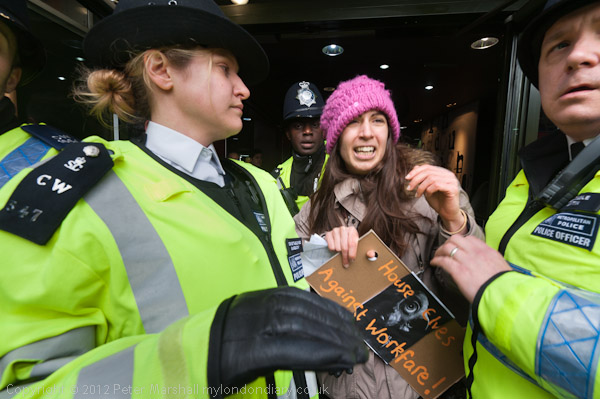
Police eject a protester from MacDonalds on Oxford St
more pictures
Boycott Workfare London met on Oxford St to protest at companies who use unemployed and disabled people forced to work under the government workfare scheme as free labour. Police stopped them or quickly ejected them when they entered a series of shops taking part in the schemes.
The protesters met outside BHS near Oxford Circus, but the short introduction to the protest started by praising that company for having withdrawn from the scheme since the protest had been planned. Approaching a hundred protesters had arrived by then and police were guarding the shop doorways and keeping a path along the rather crowded pavement clear. The protesters had brought two 'Boycott Warfare' flags on long poles, white with the letters BW and those taking part were told to follow the flags which would lead them to the mystery destination of the next protest venue.
Accompanied by a number of police we walked and ran east along Oxford St, eventually stopping outside a Pizza Hut, where police managed to stop any of the protesters entering, but the protest outside put off any customers entering for some time. There were a few short speeches and a map was distributed showing the locations of some of the other businesses in the area taking part in unfair government work experience and work programmes. These were McDonalds, Holland and Barratt, Superdrug, WH Smith, Argos, and a little way north of Oxford St, Holiday Inn and Barnado's.
As well as the group accompanying the protesters as they made their way along the street, there were quite a few other police around, some standing outside shops that had previously been targeted by UK Uncut which are not involved in workfare and so of no interest to this protest. Along with another couple of photographers I arrived well before police at the next store on the route, Holland and Barratt, but police just managed to beat the protesters, who only paused fairly briefly there before making afiurther along the street to McDonalds. There a handful managed to beat the police and get inside but were fairly rapidly ejectec into the noisy crowd milling around outside. A couple of people on the protest wheeling bikes were shoved flying by police and were fortunate not to be injured. After a few minutes of protesting there, the BW flags and some of the protesters moved off towards Argos, taking most of the police with them, but this was a feint, as I soon realised and hurried back to see another group of protesters being thrown out of McDonalds.
Boycott Workfare then moved back west, with a small group breaking away to visit Pizza Hut again, where police soon ejected them, before the whole group swung into a shopping arcade on the north side of the street. The protesters were not clear which shop they were aiming for, and police were able to rush in past them to form a barrier. After a few minutes of noisy protest the left and walked further along Oxford St, holding a brief rally on a street corner with an open microphone at which some of those on the protest and at least one passer by spoke against workfare, which actually cuts the number of proper jobs available by forcing the unemployed to do work at no cost to the employer on an allowance roughly one quarter of the minimum pay - and around a fifth of the London Living Wage.
From there the protest moved on to Holiday Inn in Wellbeck St, where again
a few protesters had beaten the police there and were rather forcibly thrown
out. I left the protesters at this point, and had seen no arrests with the
police seeming content to keep the protesters outside the stores or quickly
remove them. Generally the atmosphere on the protest was good, and some of
the officers I and protesters talked too expressed their disgust at a scheme
which forces people to work without payment, and some also had concerns about
the proposals leaked today to part-privatise the police and other cuts, but
insisted that it was their job to keep order and protect property.
more pictures
top of page
All pictures on this section of the site are Copyright © Peter Marshall 2012; to buy prints or for permission to reproduce pictures or to comment on this site, or for any other questions, contact me.
